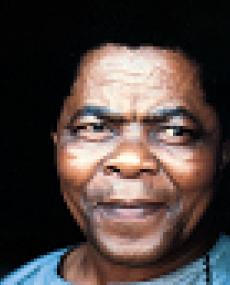
Durant Basi Sihlali was born on 5 March 1935 in an industrial area, Germiston, Transvaal, now known as Gauteng Province. Due to harsh living conditions, his parents sent him to live with his paternal grandparents in a rural village called Cala in the Eastern Cape. The wall murals Xhosa women painted captivated Sihlali, who tried to imitate the designs but was chastised for engaging in what was considered a women’s job. He resorted to copying newspaper cartoons onto toilet rolls, the only paper available.
Sihlali moved back in with his parents at the age of 14, staying with them in Moroka outside Johannesburg, Transvaal. There he began informal art classes at the Chiawelo Art Centre under Alphius Kubeka, attending from 1950 to 1953. He also learned from the artists Carlo Sdoya and Sidney Goldblatt, and studied with Cecil Skotnes at the Polly Street Recreation Centre from 1953 to 1958. He married his wife, Annah Mokholo Moloi, in 1958, and had five children with her.
As a student of Skotnes, Sihlali departed from the instructor’s approach of drawing on imaginative interpretations of traditional African sculptural forms. Instead, Sihlali worked from observations of the world around him, an approach which John Peffer notes was both conservative and radical: he resisted avant-garde art trends of the time and insisted on representing realities of urban life for blacks in South Africa.
Sihlali shared this approach with other artists such as Ephraim Ngatane, Isaac Hlatshwayo and Louis Maqhubela. Though they were not initially aware of the fact, the group’s work echoed the focus of pioneers Gerard Sekoto and John Koenakeefe Mohl in the 1930s and 1940s. Contemporary art critics categorised Sihlali’s work, along with that of many other black South African modernists, in the genre of ‘township art’. Sihlali rejected the degrading label with the argument that he was documenting the realities he observed, making the anti-apartheid resistance element of his work implicit.
From the 1960s up to the 1980s, Sihlali painted hundreds of watercolours that became, perhaps, his most dominant legacy. He also produced work in pencil, charcoal, pastels, oil paints and graphic media, along with sculptures. In the mid to late 1960s, he supported himself partly through sales of work at the outdoor market Artists under the Sun in Johannesburg’s Joubert Park. He also earned income working for commercial art firms, designing jewellery, ceramics, greeting cards and other trinkets. Dedicating himself to his paintings in the early 1970s, he considered himself a recorder of hardships imposed through apartheid and forced removals. His depictions of impending destructions and devastations remained largely in his personal collection until his death, in part due to the concerns of subjects who did not wish to have their image recorded, and in part because of his unwillingness to reduce these illustrations to entertainment or decoration for a mostly distant, predominantly white audience.
Trips abroad in the mid-1980s expanded his exposure to other artists and their work, and Sihlali’s approach shifted dramatically. He won a scholarship from the French government in 1985 which allowed him to study at the Villa Arson Art School in Nice. After travelling to Europe and taking part in conferences such as Triangle in the United States of America (USA) and Thupelo in Johannesburg, he incorporated more abstraction as well as themes from graffiti, Ndebele mural designs and cartoons.
Sihlali headed the Fine Arts Department at the Federated Union of Black Artists (FUBA) from 1983 to 1988, and taught students from the Wits Technikon and the Funda Art Centre. Until his death of a heart attack in May 2004 at his Soweto home, he exhibited work throughout South Africa, as well as in Greece, Italy, Germany, England, Canada, the USA and Botswana.
He won awards for his painting, sculptures and graphics in the 1970s and 1980s, and completed commissions for churches and private companies in the same period. Collections of his work include those at the University of Fort Hare, the Africana Museum in Johannesburg, the National Museum of Botswana and several South African corporate institutions.